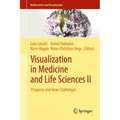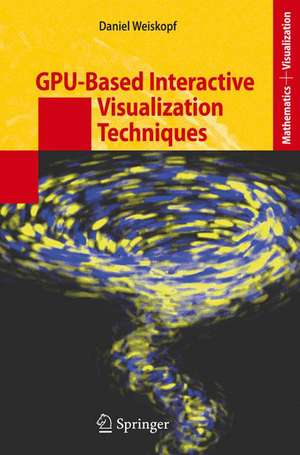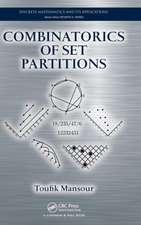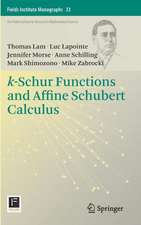GPU-Based Interactive Visualization Techniques: Mathematics and Visualization
Autor Daniel Weiskopfen Limba Engleză Hardback – 26 oct 2006
This book focuses on efficient visualization techniques, which are the prerequisite for the interactive exploration of complex data sets. High performance is primarily achieved by devising algorithms for the fast graphics processing units (GPUs) of modern graphics hardware. Other aspects discussed in the book include parallelization on cluster computers with several GPUs, adaptive rendering methods, multi-resolution models, and non-photorealistic rendering techniques for visualization. Covering both the theoretical foundations and practical implementations of algorithms, this book provides the reader with a basis to understand and reproduce modern GPU-based visualization approaches.
| Toate formatele și edițiile | Preț | Express |
|---|---|---|
| Paperback (1) | 988.66 lei 6-8 săpt. | |
| Springer Berlin, Heidelberg – 2 dec 2014 | 988.66 lei 6-8 săpt. | |
| Hardback (1) | 992.26 lei 6-8 săpt. | |
| Springer Berlin, Heidelberg – 26 oct 2006 | 992.26 lei 6-8 săpt. |
Din seria Mathematics and Visualization
- 20%
 Preț: 935.20 lei
Preț: 935.20 lei - 18%
 Preț: 960.93 lei
Preț: 960.93 lei - 18%
 Preț: 1110.41 lei
Preț: 1110.41 lei - 20%
 Preț: 994.26 lei
Preț: 994.26 lei - 18%
 Preț: 1220.57 lei
Preț: 1220.57 lei - 18%
 Preț: 958.38 lei
Preț: 958.38 lei - 15%
 Preț: 654.62 lei
Preț: 654.62 lei - 20%
 Preț: 997.38 lei
Preț: 997.38 lei - 15%
 Preț: 645.47 lei
Preț: 645.47 lei - 5%
 Preț: 1101.58 lei
Preț: 1101.58 lei - 20%
 Preț: 992.44 lei
Preț: 992.44 lei - 20%
 Preț: 1284.47 lei
Preț: 1284.47 lei - 20%
 Preț: 656.69 lei
Preț: 656.69 lei - 20%
 Preț: 476.68 lei
Preț: 476.68 lei - 20%
 Preț: 1273.08 lei
Preț: 1273.08 lei - 15%
 Preț: 649.54 lei
Preț: 649.54 lei - 20%
 Preț: 335.36 lei
Preț: 335.36 lei - 20%
 Preț: 646.95 lei
Preț: 646.95 lei - 20%
 Preț: 651.75 lei
Preț: 651.75 lei - 20%
 Preț: 657.99 lei
Preț: 657.99 lei - 18%
 Preț: 1223.74 lei
Preț: 1223.74 lei - 20%
 Preț: 333.72 lei
Preț: 333.72 lei - 20%
 Preț: 709.98 lei
Preț: 709.98 lei - 18%
 Preț: 1236.38 lei
Preț: 1236.38 lei - 20%
 Preț: 648.44 lei
Preț: 648.44 lei - 20%
 Preț: 1158.59 lei
Preț: 1158.59 lei - 20%
 Preț: 330.66 lei
Preț: 330.66 lei - 18%
 Preț: 963.91 lei
Preț: 963.91 lei - 15%
 Preț: 653.98 lei
Preț: 653.98 lei - 20%
 Preț: 991.94 lei
Preț: 991.94 lei - 18%
 Preț: 958.07 lei
Preț: 958.07 lei
Preț: 992.26 lei
Preț vechi: 1240.32 lei
-20% Nou
Puncte Express: 1488
Preț estimativ în valută:
189.86€ • 198.25$ • 156.79£
189.86€ • 198.25$ • 156.79£
Carte tipărită la comandă
Livrare economică 15-29 aprilie
Preluare comenzi: 021 569.72.76
Specificații
ISBN-13: 9783540332626
ISBN-10: 3540332626
Pagini: 330
Ilustrații: XV, 312 p.
Dimensiuni: 210 x 297 x 19 mm
Greutate: 0.56 kg
Ediția:2007
Editura: Springer Berlin, Heidelberg
Colecția Springer
Seria Mathematics and Visualization
Locul publicării:Berlin, Heidelberg, Germany
ISBN-10: 3540332626
Pagini: 330
Ilustrații: XV, 312 p.
Dimensiuni: 210 x 297 x 19 mm
Greutate: 0.56 kg
Ediția:2007
Editura: Springer Berlin, Heidelberg
Colecția Springer
Seria Mathematics and Visualization
Locul publicării:Berlin, Heidelberg, Germany
Public țintă
ResearchCuprins
Contents 1 Introduction 1.1 Visualization Pipeline and Classification of Visualization Methods 1.2 GPU Rendering Pipeline 1.3 Methods and Goals 2 Visualization of 3D Scalar Fields 2.1 Optical Model for Volume Rendering 2.2 Volume Rendering Pipeline 2.3 Volume Rendering Approaches 2.4 Maintaining Constant Frame Rates in 3D Texture-Based Volume Rendering 2.5 Volume Clipping 2.6 Hierarchical Volume Visualization on GPU Clusters 2.7 Summary 3 Vector Field Visualization 3.1 Basics of Particle Tracing 3.2 Classification and Overview of Flow Visualization Methods 3.3 Semi-Lagrangian Noise and Dye Advection on Cartesian Domains 3.4 Dye Advection Based on Level-Sets 3.5 Flow Visualization on Curved Surfaces 3.6 Spacetime Framework for Time-Dependent Vector Fields 3.7 Summary 4 Perception-Oriented and Non-Photorealistic Rendering 4.1 Previous Work 4.2 Colorand the PerceptionofMotion 4.3 Color-Based Depth-Cueing 4.4 Non-Photorealistic Rendering ofDepth Structures via Continuous Tone-Shading 4.5 Non-PhotorealisticHalftoning 4.6 Summary 5 Conclusion References Color Plates Index
Caracteristici
First book to focus on GPU methods for scientific visualization Fast growing field













